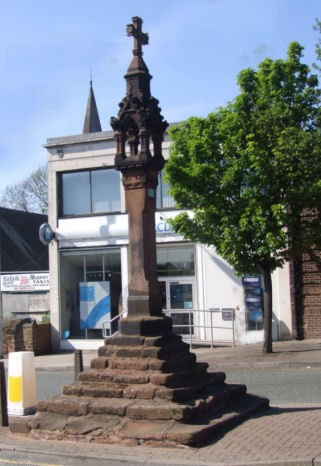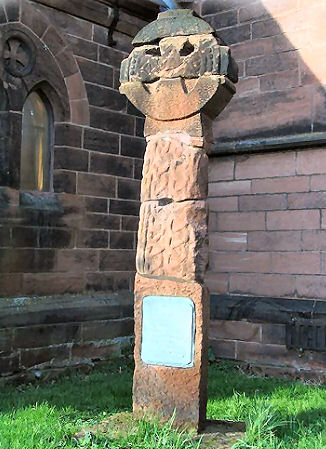Bromborough
OS grid ref:- SJ349825
 The large village of Bromborough, on the Wirral Peninsula, is a candidate for the site of the epic Battle of Brunanburh, a great English victory over the Vikings.
The large village of Bromborough, on the Wirral Peninsula, is a candidate for the site of the epic Battle of Brunanburh, a great English victory over the Vikings.
The Battle of Brunanburh
The battle was fought in 937, by an Anglo-Saxon army under the command of Æthelstan, King of England, and his brother Edmund against the combined Viking armies of Olaf III Guthfrithson, the Norse-Gael King of Dublin, Constantine II, King of Scots, and Owen I, King of Strathclyde. Brunanburh has been called "the greatest single battle in Anglo-Saxon history before Hastings".
The Annals of Ulster record 'A huge war, lamentable and horrible, was cruelly waged between the Saxons and Norsemen. Many thousands of Norsemen beyond number died although King Anlaf escaped with a few men. While a great number of the Saxons also fell on the other side, Athelstan, king of the Saxons, was enriched by the great victory.'
The name derives from Old English Brunanburh, which means 'Brun's fort'. While doubt will always remain as to the location of the battle, the evidence of history, folklore studies, and literature all suggest Bromborough to be the most likely contender. Egil's Saga, a story which tells of the battle, may have referred to Wirral as Wen Heath, Vínheíþr in Icelandic.
To add to the confusion regarding the exact site of the battle, its location appears in various forms in the sources: Brunanburh (in the Anglo-Saxon Chronicle or the chronicle of John of Worcester, or in accounts derived from them), Brunandune (Aethelweard), Brunnanwerc or Bruneford or Weondune (Symeon of Durham and accounts derived from him), Brunefeld or Bruneford (William of Malmesbury and accounts derived from him), Duinbrunde (Scottish traditions), Brun (Welsh traditions).
According to Michael Livingston, the case for a location in the Wirral has strong support among current historians. Due to the fact that the earliest sources in the Anglo-Saxon Chronicle locate the battle as taking place "ymbe Brunanburh" ("around Brunanburh"), numerous locations on the Wirral near Bromborough have been put forward as the site of the battle, including the Brackenwood Golf Course in Bebington.
 The village is mentioined in the Domesday Book of 1087, where it is recorded as having a watermill. Edward I granted Bromborough a charter for a market to be held each Monday in 1278. The steps of the red sandstone market cross are from the original thirteenth century monument. The cross itself is a more recent reproduction.
The village is mentioined in the Domesday Book of 1087, where it is recorded as having a watermill. Edward I granted Bromborough a charter for a market to be held each Monday in 1278. The steps of the red sandstone market cross are from the original thirteenth century monument. The cross itself is a more recent reproduction.
The red sandstone village church of St. Barnabas dates to 1862, the first church to occupy the site was built in 928 next to a monastery which had probably been founded in 912, by Ethelfleda, Lady of Mercia, daughter of King Alfred the Great. This Saxon church was demolished and replaced in 1828 and again in 1862 when it was replaced by the present building. The stained glass windows in the building depict the Saxon King Athelstan, the victor of Brunanburh, Kind Edward I, Gilbert Scott the architect, St.Barnabas the apostle and Queen Victoria.
An Anglo-Viking preaching cross (pictured left) dating from around the tenth century stands in the churchyard. This was re-erected from 3 fragments by the Bromborough Society in 1958. The fragments were uncovered during Victorian rebuilding work at St Barnabas. Other Saxon stones, and later period, are kept in the parsonage garden.
Nearby places of interest
The National Waterways Museum at Ellesmere Port, is situated at the northern end of the Shropshire Union Canal where it enters the Manchester Ship Canal. It contains the largest collection of canal boats in the world. With its fascinating displays housed in a fine collection of Victorian buildings, the museum makes a great day out whatever the weather.
The Blue Planet Aquarium at Ellesmere Port is the largest aquarium in the UK, and boasts two floors of interactive displays and exhibits. The Blue Planet holds more sharks than anywhere else in Britain, holding more than ten different species from around the world including sand tiger sharks.
Brotherton Park, a nature reserve, is a one of the finest examples of ancient woodland on the Wirral and once formed part of the Royal forest of Wirral dating back to the end of the last ice age. Other habitats on the reserve include wildflower meadows, reed swamps and historic parkland. Brotherton Park and Dibbinsdale comprises of 47 hectares of semi-natural countryside along the valley of the River Dibbin.
Eastham Country Park is situated on the banks of the River Mersey, the park covers a hundred acres and contains some of the finest mature trees to be found on the Wirral. The park offers excellent views across the estuary and the cliffs at provide superb sites for viewing the flocks of waders and ducks on the estuary. Much of the Estuary is now designated a Site of Special Scientific Interest.
Leasowe Lighthouse Constructed of hand made brick in 1763 by the Mersey Docks and Harbour Board, Leasowe Lighthouse on the Wirral Peninsula is the oldest brick built lighthouse in the United Kingdom.
